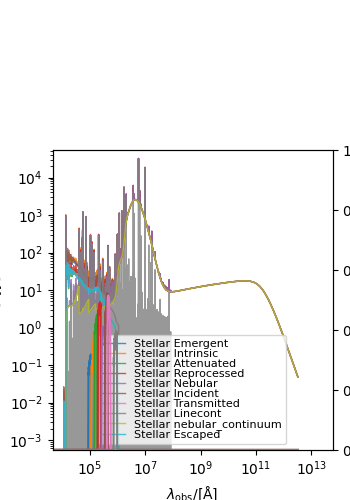Note
Go to the end to download the full example code.
Generate parametric observed SED¶
Example for generating the observed spectrum for a parametric galaxy including photometry. This example will: - build a parametric galaxy (see make_sfzh and make_sed) - calculate spectral luminosity density (see make_sed) - calculate observed frame spectra (requires comsology and redshift) - calculate observed frame fluxes

JWST/NIRCam.F090W: 0.00 erg/(Hz*cm**2*s)
JWST/NIRCam.F115W: 0.00 erg/(Hz*cm**2*s)
JWST/NIRCam.F150W: 0.00 erg/(Hz*cm**2*s)
JWST/NIRCam.F200W: 0.00 erg/(Hz*cm**2*s)
JWST/NIRCam.F277W: 0.00 erg/(Hz*cm**2*s)
JWST/NIRCam.F356W: 0.00 erg/(Hz*cm**2*s)
JWST/NIRCam.F444W: 0.00 erg/(Hz*cm**2*s)
JWST/MIRI.F770W: 0.00 erg/(Hz*cm**2*s)
from astropy.cosmology import Planck18 as cosmo
from unyt import Msun, Myr
from synthesizer.emission_models import PacmanEmission
from synthesizer.emission_models.attenuation import PowerLaw
from synthesizer.emission_models.attenuation.igm import Madau96
from synthesizer.filters import FilterCollection
from synthesizer.grid import Grid
from synthesizer.parametric import SFH, Stars, ZDist
from synthesizer.parametric.galaxy import Galaxy
if __name__ == "__main__":
# Get the location of this script, __file__ is the absolute path of this
# script, however we just want to directory
# script_path = os.path.abspath(os.path.dirname(__file__))
# Define the grid
grid_name = "test_grid"
grid_dir = "../../tests/test_grid/"
grid = Grid(grid_name, grid_dir=grid_dir)
# Define the emission model
model = PacmanEmission(
grid,
tau_v=0.1,
fesc=0.5,
fesc_ly_alpha=0.5,
dust_curve=PowerLaw(slope=-1),
)
# define filters
filter_codes = [
f"JWST/NIRCam.{f}"
for f in [
"F090W",
"F115W",
"F150W",
"F200W",
"F277W",
"F356W",
"F444W",
]
] # define a list of filter codes
filter_codes += [f"JWST/MIRI.{f}" for f in ["F770W"]]
fc = FilterCollection(filter_codes, new_lam=grid.lam)
# define the parameters of the star formation and metal enrichment
# histories
sfh_p = {"max_age": 10 * Myr}
Z_p = {
"log10metallicity": -2.0
} # can also use linear metallicity e.g. {'Z': 0.01}
stellar_mass = 1e8 * Msun
# define the functional form of the star formation and metal enrichment
# histories
sfh = SFH.Constant(**sfh_p) # constant star formation
metal_dist = ZDist.DeltaConstant(**Z_p) # constant metallicity
# get the 2D star formation and metal enrichment history for the given SPS
# grid. This is (age, Z).
stars = Stars(
grid.log10age,
grid.metallicity,
sf_hist=sfh,
metal_dist=metal_dist,
initial_mass=stellar_mass,
)
# Define redshift
z = 10.0
# create a galaxy object
galaxy = Galaxy(stars, redshift=z)
# generate spectra using pacman model (complex)
sed = galaxy.stars.get_spectra(model)
# now calculate the observed frame spectra
sed.get_fnu(
cosmo,
z,
igm=Madau96,
) # generate observed frame spectra, assume Madau96 IGM model
# measure broadband fluxes
fluxes = sed.get_photo_fnu(fc)
# print broadband fluxes
for filter, flux in fluxes.items():
print(f"{filter}: {flux:.2f}")
# Calculate the observed spectra for all stellar spectra
galaxy.get_observed_spectra(cosmo, igm=Madau96)
# make plot of observed including broadband fluxes (if filter collection
# object given)
galaxy.plot_observed_spectra(
filters=fc,
show=True,
combined_spectra=False,
stellar_spectra=True,
)
Total running time of the script: (0 minutes 5.591 seconds)